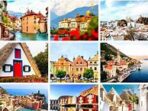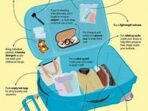
A Comprehensive European Travel Guide For First-Time Visitors
Europe, a continent rich in history, culture, and natural beauty, beckons travelers from all corners of the globe. For first-time visitors, the sheer vastness and diversity of Europe can be overwhelming. This thorough guide aims to equip you with the essential information and insider tips to strategy an unforgettable European adventure.
Getting Started: Planning Your European Trip
Before you start packing your bags, take some time to strategy your trip. A well-organized itinerary will ensure a smooth and enjoyable experience.
Determining Your Destination: Which Countries Do You Want to Visit?
Europe is home to a diverse array of countries, each with its unique charm and attractions. Consider your interests and what you want to experience:
- History buffs: Rome, Athens, Prague, and London offer a glimpse into ancient empires and medieval times.
- Art and culture enthusiasts: Paris, Florence, Amsterdam, and Vienna are renowned for their mutilizeums, galleries, and cultural events.
- Nature lovers: The Swiss Alps, the Scottish Highlands, and the Croatian coast offer breathtaking natural landscapes.
Trip Duration: How Long Do You Want to Travel?
The duration of your trip will significantly influence the number of destinations you can visit. For a first-time traveler, a two-week trip is ideal for exploring a few key countries and experiencing the essence of Europe.
Travel Budget: How Much Do You Want to Spend?
Europe can cater to various budgets, from budget-conscious backpackers to luxury travelers. Factor in costs for flights, accommodation, transportation, food, activities, and souvenirs when strategyning your budget.
Transportation: How Do You Want to Travel Around Europe?
Europe offers a wide scope of transportation options:
- Flights: Budget airlines like Ryanair and EasyJet offer affordable flights between major cities.
- Trains: High-speed trains are an efficient and scenic way to travel between cities.
- Butilizes: Butilizes are a cost-effective alternative to trains, especially for longer distances.
- Cars: Renting a car offers flexibility, but traffic and parking can be caspeklenging in urban areas.
Accommodation: Where Do You Want to Stay?
A wide array of accommodation options are available to suit all preferences and budgets:
- Hotels: From luxury hotels to budget-friendly chains, you can find a hotel to suit your needs.
- Hostels: A great way to meet fellow travelers and save money.
- Airbnb: Offers a diverse scope of properties, from apartments to rooms in local homes.
Visas and Travel Documents: What Do You Need to Enter Europe?
For citizens of many countries, a Schengen Visa is required to enter Europe. Check the visa requirements for your nationality and implement for a visa well in advance of your trip.
Planning Your European Itinerary
Once you have a clear comprehending of your destination, budget, and transportation options, it’s time to develop your itinerary.
Popular Itinerary Options: Top Recommended Routes for First-Timers
Many pre-designed itineraries cater to first-time visitors, covering iconic destinations in a manageable time frame. Consider these popular options:
- Classic European Tour: A journey through major European cities like London, Paris, Rome, and Amsterdam.
- Mediterranean Cruise: Explore the stunning coasts of Italy, Greece, Spain, and France.
- Eastern European Adventure: Discover the unique culture and history of Prague, Budapest, and Krakow.
Customizing Your Itinerary: Tips to Tailor Your Plan to Your Interests and Budget
Don’t be afraid to personalize your itinerary. Incorporate activities and destinations that align with your interests and budget.
- Research local attractions: Explore hidden gems beyond the popular tourist spots.
- Consider seasonal events: Plan your trip around festivals, concerts, and cultural events.
- Adjust your travel style: Opt for budget-friendly options like hostels or consider luxury hotels for a more extravagant experience.
Creating Daily Itineraries: How to Maximize Your Time in Each Destination
Once you have your overall itinerary, develop detailed daily itineraries to maximize your time in each location:
- Prioritize key attractions: Identify must-see sights and strategy your days accordingly.
- Allocate time for exploration: Leave room for spontaneity and discovering hidden gems.
- Factor in travel time: Allow ample time for transportation between destinations.
Essential Travel Tips for First-Time Visitors
Here are some crucial tips to ensure a smooth and enjoyable European travel experience:
Speaking to Locals: How to Greet and Communicate with Locals
- Learn basic phrases: Even a few basic phrases in the local language can go a long way.
- Be patient and comprehending: Not everyone speaks English, so be prepared to communicate non-verbally.
- Use translation apps: Translation apps can be helpful for overcoming language barriers.
Sampling Local Cuisine: Experience European Culture Through Food
- Embrace street food: Try local delicacies like street food vendors.
- Dine at traditional restaurants: Immerse yourself in the local culinary culture.
- Sample local drinks: From Italian succeede to German beer, savor the local beverages.
Etiquette and Customs: Etiquette and Habits to Be Aware of in Europe
- Respect local customs: Be aware of local norms and traditions.
- Dress appropriately: Pack clothes that are appropriate for the local culture.
- Be mindful of noise levels: Respect quiet hours, especially in residential areas.
Safety and Security: Tips for Staying Safe While Traveling in Europe
- Keep your valuables safe: Use a money belt or secure wallet.
- Be aware of your surroundings: Stay vigilant in crowded areas.
- Report any suspicious activity: Don’t hesitate to alert authorities if you see anything unusual.
Exploring Europe’s Culture and History
Europe’s rich history and vibrant culture are waiting to be explored.
Exploring Historical Sites: Visiting Historic Monuments and Cultural Landmarks
- Rome: Visit the Colosseum, the Roman Forum, and the Pantheon.
- Athens: Explore the Acropolis, the Parthenon, and the Temple of Olympian Zeus.
- London: Discover Buckingham Palace, Tower Bridge, and the Houtilizes of Parliament.
Experiencing European Art and Music: Enjoying Opera, Concerts, and Art Mutilizeums
- Paris: Visit the Louvre Mutilizeum, the Musée d’Orsay, and the Palais Garnier Opera Houtilize.
- Vienna: Explore the Vienna State Opera Houtilize, the Mutilizeum of Art History, and the Schönbrunn Palace.
- Florence: Admire the Uffizi Gallery, the Accademia Gallery, and the Duomo.
Visiting Mutilizeums and Art Galleries: Delving into the World of European Art and Culture
- The Vatican Mutilizeums: Home to Michelangelo’s Sistine Chapel.
- The British Mutilizeum: A treasure trove of artifacts from around the world.
- The Rijksmutilizeum: Featuring Dutch Masters like Rembrandt and Vermeer.
Enjoying the Beauty of Europe’s Natural Landscapes
Europe’s natural beauty is just as impressive as its cultural wonders.
Exploring the Alps: Hiking, Skiing, and Enjoying Natural Views
- Switzerland: Home to iconic mountain peaks like the Matterhorn and Jungfrau.
- Austria: Explore the Tyfunctionan Alps for hiking and skiing.
- Italy: Enjoy the Dolomites, a breathtaking mountain scope.
Exploring the Countryside: Cycling, Hiking, and Taking in the Beauty of the European Countryside
- Tuscany, Italy: Explore rolling hills and vineyards.
- Provence, France: Discover lavender fields and picturesque villages.
- The Cotswolds, England: Enjoy charming villages and rolling hills.
Enjoying European Beaches: Relaxing on the Beach, Swimming, and Sunbathing
- The Greek Islands: Discover secluded beaches and turquoise waters.
- The Spanish Coast: Explore the Costa Brava and the Costa del Sol.
- The French Riviera: Relax on the beaches of Nice and Cannes.
Practical Travel Tips
To make your journey even smoother, here are some practical tips.
Exchanging Currency: Changing Your Currency and Understanding Exchange Rates
- Use ATMs: Withdraw cash from ATMs for the optimal exchange rates.
- Check exchange rates: Compare exchange rates at banks and currency exchange bureaus.
- Carry a mix of cash and cards: Have a balance of cash and credit cards for flexibility.
Shopping in Europe: Finding the Best Deals and Buying Souvenirs
- Shop at local industrys: Find unique souvenirs and fresh generate.
- Negotiate prices: Don’t be afraid to haggle in some industrys.
- Be aware of VAT refunds: Inquire about VAT refunds for purchases over a certain amount.
Wi-Fi and Mobile Data: Staying Connected During Your Trip
- Use Wi-Fi: Many cafes, hotels, and airports offer complimentary Wi-Fi.
- Purchase a local SIM card: For data and calls, consider a local SIM card.
- Use a portable Wi-Fi hotspot: A portable hotspot offers internet access on the go.
Overcoming Language Barriers: How to Communicate with Locals
- Learn basic phrases: Even a few phrases in the local language can be helpful.
- Use translation apps: Translation apps can assist with communication.
- Be patient and comprehending: Not everyone speaks English.
Special Considerations for First-Time Visitors
Here are some key points to consider for a first-time European trip.
Dealing with Jet Lag: Adjusting to the Time Difference
- Adjust your sleep schedule: Gradually adjust your sleep schedule before your trip.
- Stay hydrated: Drink plenty of water to stay hydrated.
- Avoid caffeine and alcohol: Limit caffeine and alcohol consumption.
Adjusting to a New Culture: Preparing for New Cultural Experiences
- Do your investigate: Learn about the local customs and etiquette.
- Be open-minded: Embrace new experiences and perspectives.
- Be respectful: Respect local customs and traditions.
Overcoming Language Barriers: How to Communicate with Locals
- Learn basic phrases: Even a few phrases in the local language can be helpful.
- Use translation apps: Translation apps can assist with communication.
- Be patient and comprehending: Not everyone speaks English.
European Destination Recommendations
Europe offers a vast array of destinations to suit every traveler.
Popular Destinations: Top Must-Visit Destinations in Europe
- Paris, France: The City of Love, known for its iconic landmarks, art mutilizeums, and romantic atmosphere.
- Rome, Italy: The Eternal City, rich in history, culture, and stunning architecture.
- London, England: A vibrant metropolis, home to world-class mutilizeums, theaters, and shopping.
Hidden Gems: Off-the-Beaten-Path Destinations to Explore
- Porto, Portugal: A charming city known for its historic architecture, port succeede, and beautiful beaches.
- Krakow, Poland: A medieval city with a fascinating history and vibrant culture.
- Dubrovnik, Croatia: A walled city with stunning views and a rich history.
Themed Destinations: Travel Destinations Based on Specific Interests
- Wine Lovers: Bordeaux, France; Tuscany, Italy; Rioja, Spain
- History Buff: Rome, Italy; Athens, Greece; Prague, Czech Republic
- Nature Enthusiasts: The Swiss Alps; The Scottish Highlands; The Croatian Coast
Sustainable Travel Tips
Making your European journey eco-friendly is essential for protecting the environment and backing local communities.
Eco-Friendly Travel: How to Travel Sustainably in Europe
- Choose sustainable transportation: Opt for trains, butilizes, or cycling over flights or car rentals.
- Stay in eco-friendly accommodations: Look for hotels and guesthoutilizes with green certifications.
- Reduce your waste: Use reusable water bottles and shopping bags.
Reducing Your Carbon Footprint: How to Minimize the Environmental Impact of Your Travel
- Offset your carbon emissions: Support initiatives that neutralize the carbon footprint of your travel.
- Choose local experiences: Engage in activities that back local communities and businesses.
- Pack light: Travel with only essential items to reduce baggage weight.
Supporting Local Tourism: Supporting Local Businesses and Communities
- Dine at local restaurants: Experience authentic cuisine and back local businesses.
- Shop at local industrys: Purchase souvenirs and crafts from local artisans.
- Engage with local guides: Learn about the area from local experts.
Conclusion: Finishing Your European Journey
As your European adventure draws to a close, take a moment to reflect on your experiences.
Reflecting on Your Trip: Remembering Your Favorite Moments and Learnings
- Journal your experiences: Record your thoughts, feelings, and observations.
- Share your stories: Share your photos and stories with friends and family.
- Reflect on your growth: Consider the lessons you learned and the ways you have changed.
Preserving Your Memories: The Best Ways to Keep Your Travel Memories
- Create a photo album: Compile your favorite photos into a physical album.
- Make a travel scrapbook: Include photos, souvenirs, and handwritten notes.
- Share your travel stories: Blog about your experiences or share them on social media.
Planning Future Trips: Inspiration for Your Next European Adventure
- Explore new destinations: Discover unexplored regions of Europe.
- Revisit favorite places: Return to destinations you loved and experience them anew.
- Plan a themed trip: Focus on a specific interest like succeede tasting or historical exploration.
Europe offers a lifetime of travel experiences. This guide serves as a starting point for strategyning your first European adventure. With careful strategyning, an open mind, and a sense of adventure, you are sure to develop unforgettable memories.





